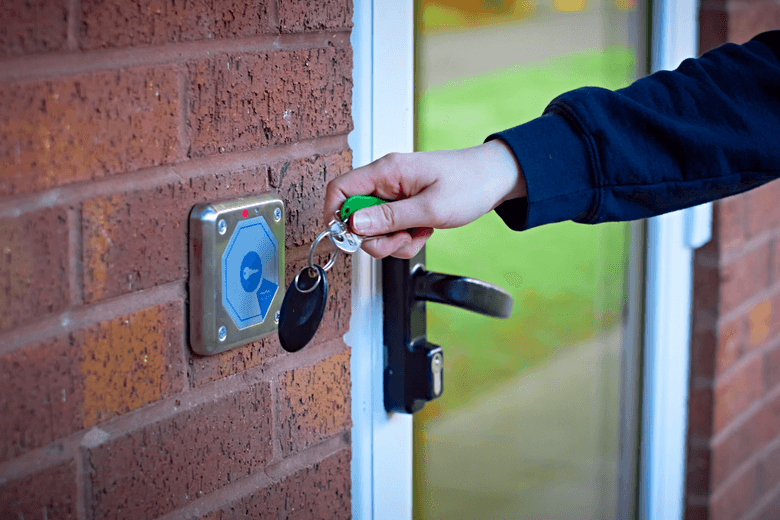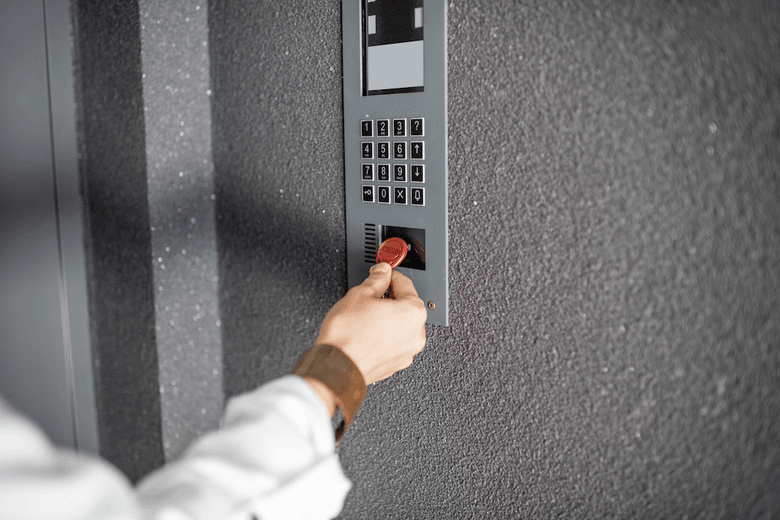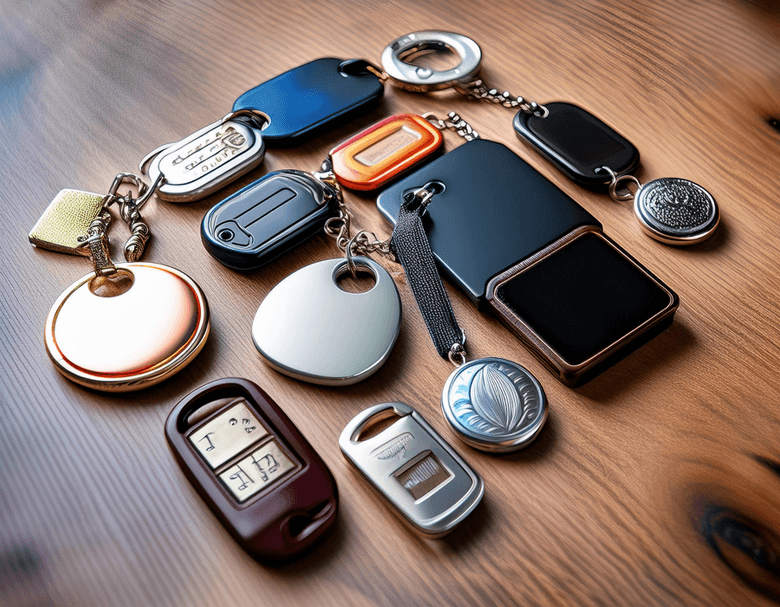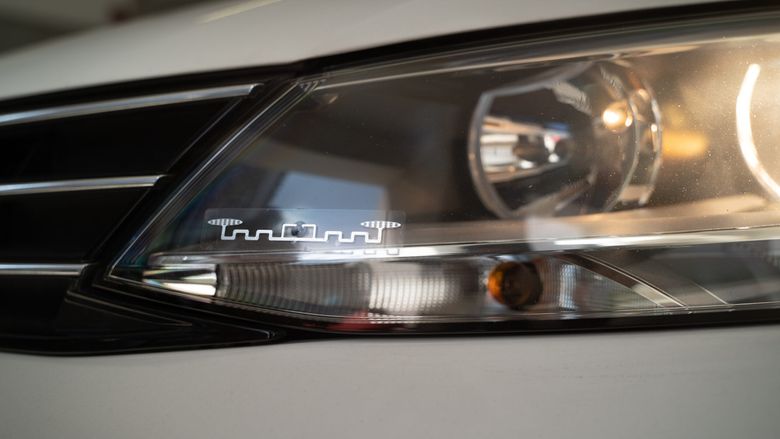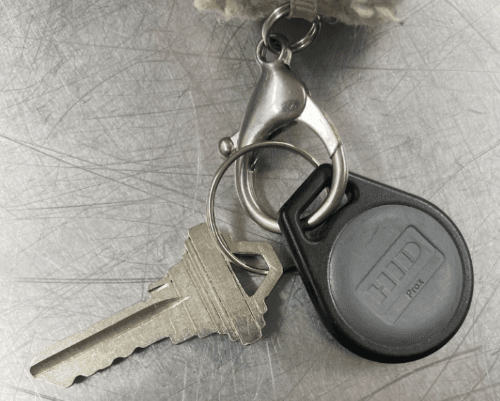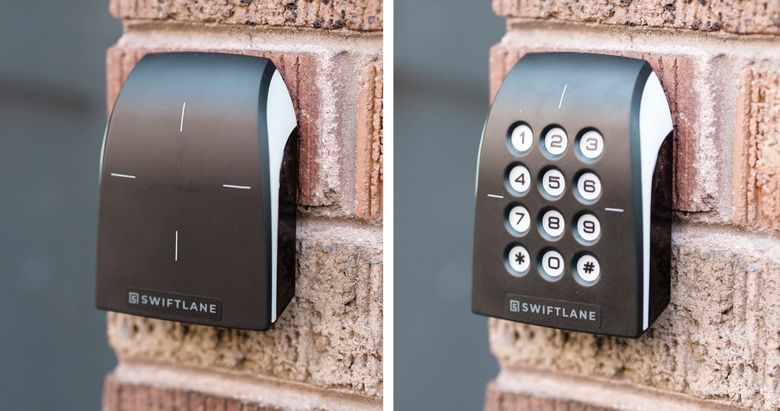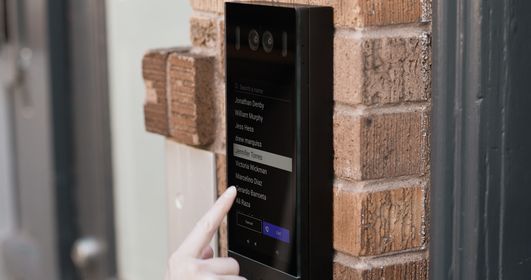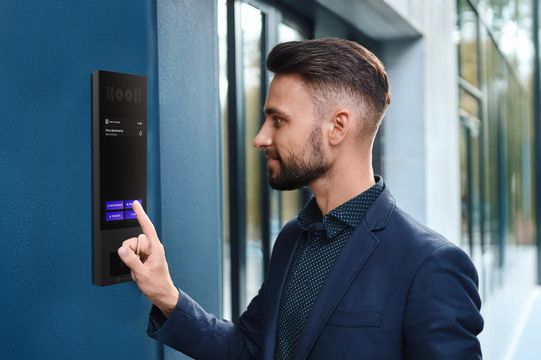Article Updated on: 21st March 2025
A good chunk of property upselling depends on its access control system, typically one that offers both high-grade security and convenience. With newer technology vying for attention, you must be selective about the devices you choose for your property. Among a growing range of access control solutions for multifamily security, key fob systems have become a gold standard.
Key fobs help you manage who comes in and out of a building and are an excellent replacement for outdated metal keys. These access control devices are easy to use, have encrypted credentials for trackability, and work on RFID technology.
Today’s key fob systems also integrate with cloud-based platforms, mobile apps, and smart intercoms, allowing property managers to control access remotely and ensure only authorized individuals can enter.
We’ve curated this guide for property owners, managers, and board members of co-ops, condos, and HOAs who want to modernize their access control systems. We’ll break down everything you need to know so you can make informed decisions and maximize your property’s NOI with smart building security.
Table of Contents
- What is an Apartment Key Fob System?
- What are the Different Types of Key Fobs?
- How Do I Know Which Key Fob to Choose?
- Major Manufacturers of Apartment Key Fob Systems
- Installing a Key Fob System for Apartments
- How Much Does a Key Fob System Cost?
- Why Choose Swiftlane for Apartment Key Fob Access?
- Frequently Asked Questions
What is an Apartment Key Fob System?
An apartment key fob system is a physical access control system that uses key fobs and an electronic key. The fob serves as a credential that allows authorized persons to access the common areas of an apartment or condominium building.
It can also serve a similar purpose in a gated community or any residential campus. You can find fob use cases at vehicle entryways, pedestrian gates, and shared-use facilities like a clubhouse or pool here.
In residential key fob systems, residents are typically issued quarter-sized key fobs. You can also call these key tags, and they fit on their key ring. You can also use credit card-shaped key cards, which are more common in commercial buildings or hotels/motels. Residents “tap” their key tags near a proximity reader built into the wall at various building doors and gates.
Longer-range battery-powered key fobs can also open doors or vehicle gates from a greater distance. Meanwhile, RFID stickers are a kind of fob that can be placed on vehicles to open driveways and parking area gates as the car approaches.
Key fobs are great for residential properties. Residents can use a single fob at multiple entry points, including the main door, a mail room, lounges, and parking areas.
You can also issue key tags to building staff and frequent delivery people. Using these, they can provide maintenance or safely deliver packages indoors without hiring full-time door or gate staff.
How Do Key Fobs Work for Apartments?
A proximity reader installed at building entryways sends a radio wave in common frequencies. You may have heard of these as radio frequency identification (RFID), near-field communications (NFC), and Bluetooth Low Energy (BLE). The credential sends a signal back to the reader, which the reader cross references with a system database. If the credential has been authorized to open that particular door or gate, it opens using a magnetic or electronic door lock mechanism.
Are Key Fobs Safe for Apartments?
Key fobs for apartments have many security benefits but also a few notable shortcomings. Overall, they are a safe choice for access control that can enhance residential building security. Like other lock mechanisms, they are not fool-proof.
Safety benefits include:
- Security records: Each resident is allocated a unique key fob, and their times of entry can be recorded in a database. Building management can use credentials linked to the user database to track who is coming in and out, the time of entries, and get overall data about building traffic.
- Intercom integration: Key fob systems can be part of a telephone call box or, better yet, a video intercom. This gives residents a way to screen visitors and keep the building safe.
- Remote deactivation: You can deactivate key fobs remotely when someone moves out or when a key fob is reported lost or stolen. This means you can keep the building secure without changing the locks.
- Touchless entry format: Post-COVID, it has become natural for people to avoid common surfaces. Key fobs work over radio waves and provide a contactless way to get into a building (unlike devices that require you to push a button).
- Granting limited access: Not everyone requires access to all common spaces. With key fobs, you can restrict tenants’ access to certain areas (poolside, gym) and enable time-specific access.
Safety disadvantages are:
- Many can be copied: You can copy most key fobs using equipment available on the Internet, which basically exposes your property to anyone who has the know-how. Fobs are not a foolproof security method if you have high-security needs. Facial recognition is one access method that avoids this problem.
- Most work in short ranges: It isn’t really a benefit if you still have to fish for a key fob within your bag like you do with a physical key. With most fobs, you need to tap the device on the reader to gain entry, although you can get a long-range key fob at a higher price.
- Higher cost: You need a unique key fob for each tenant to access the building independently. If your building has multiple units, key fobs build up a significant cost for management.
What are the Different Types of Key Fobs?
Passive vs. Active Key Fobs
Passive key fobs grant access without pressing any buttons. They work only when they’re close to the access point, such as by “tapping” it at the proximity reader. Active key fobs are battery-powered and send signals over longer distances (up to 100 feet) using the same technology as a remote car key with lock/unlock buttons. They necessitate user intervention by physically pressing a button on the fob to unlock the access point.
Unencrypted vs. Encrypted Key Fobs
Not all key fobs offer the same level of security. Unencrypted key fobs store their access credentials in plain text, making them vulnerable to duplication. Anyone with access to a cloning device—easily found online—can copy an unencrypted fob in seconds, creating a major security risk.
On the other hand, encrypted key fobs use advanced communication protocols to send secure, scrambled data between the fob and the reader. This encryption makes it nearly impossible to duplicate a fob without authorization, significantly reducing the risk of unauthorized access.
Car RFID tags
A comprehensive residential key fob system can include RFID tags for cars, which trigger gates to open at driveways, neighborhood entry points, or parking garages without the driver having to lean out the window to use their key tag. These small stickers or tags, typically placed on a car’s windshield or near the license plate, trigger a proximity-based RFID reader to open the gate as the vehicle approaches automatically.
This hands-free solution is especially useful in high-traffic areas where manual key fobs may slow your entry. Plus, because each tag is uniquely assigned to a vehicle, property managers can track who comes and goes and easily deactivate lost or stolen tags for enhanced security.
Mobile phones
Using mobile phones as fobs is the future of access control. Using the same “tap to pay” technology built into today’s smartphones, you can use your phone to grant you entry, saving you the trouble of carrying a separate fob. Mobile phones are also encrypted, making it extremely hard to make an illegal copy of your phone as a key tag.
Biometric fobs
For buildings that require the highest level of security, biometric key fobs offer next-gen authentication. These battery-powered devices have built-in fingerprint scanners and need the residents to touch the reader before their credentials are verified. Since biometric data is unique to each person and impossible to duplicate, these fobs eliminate the risk of credential sharing or unauthorized duplication.
Biometric access control is considered a premium feature not every building has. If you’re looking to differentiate your multifamily property, investing in biometric access control would be a wise option.
How Do I Know Which Key Fob to Choose?
If you are investigating apartment key fob systems, you’ll want to keep in mind the following features and characteristics:
Key Fob Security Level
Standard 125 Khz key fob systems are the cheapest because they use standard generic unencrypted key fobs. However, they are easy to copy and don’t provide the highest level of security. Buildings with high-profile residents may want to invest the extra money in encrypted key fob systems that use one of the following communications protocols: Desfire, 13.56 Mhz, or Mifare.
Key Fob Type
Many apartment key fob systems can work with multiple types of credentials so that you can choose the best credential type for your residents. They include key tags, key cards, or, these days, using a mobile phone as the credential. With many systems, you can also issue stickers, which can function as vehicle tags.
System Integration
Inquire if the key fob system integrates with other access control and security features already installed at your building, including electronic door strikes, video intercoms or call boxes, and security cameras. If you have multiple points of entry that need access control, ask if the key fobs system integrates with door controls at multiple entry points in a building (such as a mailroom, pool, gym, etc.)
Features
Does the key fob system come as part of a system that includes other features beneficial to your building? These include pin pad access, an intercom, video, and remote management software.
Cost
Hardware for a basic key fob system could cost as little as $500 for just a basic proximity card reader and package of credentials. Integrated systems, such as one including a video intercom with a key fob reader, can cost from $1,500 to $5,000. Installation costs are separate. Some key fob systems today require additional hardware to run the software and system database, while others do this in the cloud, usually for a nominal monthly fee.
Capacity
Check whether your potential key fob system can scale to the number of potential users in your building. As your properties expand manifold, scalability is an important consideration to keep in mind while purchasing an access control system.
Key Fob Software and Programming
If you are looking for a new installation of a key fob system, we suggest you look for systems with cloud-based remote management software to program the system.
Older apartment key fob systems required a computer installed at each building, often with clunky software to manage the database of key fobs. Someone would have to physically go to this computer and add or remove each user as people moved in or out or if a fob became lost or stolen.
Many key fob system providers today offer a cloud-based management platform that building managers can log into from any computer. This saves building managers significant time and labor from programming key fob systems at each entry point, especially if they manage multiple buildings. System providers typically charge a monthly subscription fee to use these platforms, which you can easily recoup in reduced operating costs.
Major Manufacturers of Apartment Key Fob Systems
We provide a sample of major manufacturers specializing in apartment key fob systems. However, there are dozens of potential manufacturers beyond this list of some of the biggest names.
Aiphone
A global manufacturer of intercom systems known for producing high-quality communication and security products. The company designs and manufactures various intercom solutions for residential, commercial, and industrial applications. These systems typically include audio and video intercoms, door stations, and integrated access control systems.
HID Global (part of ASSA ABLOY)
A global leader in smart cards, key fobs, and mobile access solutions. HID provides scalable access control systems for various residential, commercial, and government applications, offering advanced options such as biometric authentication and two-factor security for high-level protection. Their low-cost, unencrypted passive key fobs are ubiquitous.
Swiftlane
Our company specializes in access control systems integrating video intercoms with facial recognition technology. These modern, sleek consoles are ideal for residential buildings of all sizes and small to medium-sized offices. Users can choose from multiple entry options, including traditional key fobs, mobile phone tap access, or using facial recognition to unlock doors.
DoorKing
DoorKing focuses on telephone call box entry systems, commonly used in large apartment complexes. Known for their durability and ability to withstand harsh weather, Doorking offers three models that include key fob access, although these systems do not feature video capabilities.
Giesecke+Devrient (G+D)
This global technology company specializes in key fobs with built-in biometrics. One of its well-known product lines is StarSign, which has key fobs with fingerprint readers so an unauthorized user cannot use them. This could be an important feature in a high-security residential setting.
Installing a Key Fob System for Apartments
Many companies, including the sample above, manufacture key fob system hardware and components like electronic door strikes, call boxes, and intercoms. However, while these companies produce the hardware, the actual installation is often handled by third-party companies, known as “system integrators,” located across the country. Installing these systems is typically not a DIY project unless your residential property has an in-house staff skilled in electrical engineering and security system setup.
Most access control systems require wiring to connect them to the building’s power supply and the door release mechanism. Systems that use cloud-based databases may also need an internet connection. Since different manufacturers often produce door release mechanisms and key fob systems, integrating these components requires expertise. This is why professional installation is usually recommended.
Most hardware manufacturers can recommend experienced installation companies familiar with their products in your area.
How Much Does a Key Fob System Cost?
For a basic single entry point with a simple key fob system, costs generally start at $500 but typically range closer to $1,000 for a basic proximity card reader and a computer to store the database. Newer systems may offer cloud-based databases, which can reduce upfront costs but add a monthly service fee while providing an easier platform for managing the system.
Modern fob systems are often integrated with call boxes or video intercoms. Depending on the features included, the first entry point can range from $1,500 to $5,000, with lower costs for additional doors that don’t require intercoms.
If you use key fobs or cards rather than mobile phones for access, you’ll also need to factor in the cost of credentials. Standard credentials typically range from $5 each for passive unencrypted fobs sold in large packs to $50 per user for active or encrypted fobs.
In addition to the hardware and software, there is usually a one-time professional installation fee. These fees vary based on your location and the system’s complexity, such as whether you need to cover just one or multiple entry points. Your system integrator or hardware provider can help provide more accurate cost details.
If you’re looking for a starting point for key fob system pricing, consider getting a quote from Swiftlane.
Why Choose Swiftlane for Apartment Key Fob Access?
- Our key fobs are part of a video intercom system that allows residents to screen visitors and remotely unlock the doors from anywhere using their smartphones.
- Residents gain access to doors using facial recognition, meaning they don’t have to fish out their key fob most of the time.
- Residents can loan out their key fobs to their guests to let themselves in.
- Use your smartphone as the key fob with no additional equipment.
- Building management can use our cloud-based management platform to control the system, add and remove users, and change resident permissions remotely.
Get a quote from us and learn more.
Frequently Asked Questions
Can I program an apartment key fob myself?
Building managers/owners CAN typically program an apartment key themselves, once the system is installed. Your installer will give you the necessary hardware and software so that you can manage the system and add or remove users and give out new key fobs to residents as needed.
If you are a building resident, you typically CANNOT program a key fob by yourself since you need access to the management software.
Can you copy a key fob?
Copying a key fob, also known as “cloning,” is not as easy or straightforward as copying metal keys at any local hardware store. It requires specialized RFID reader equipment that most people or stores don’t carry but that you can easily purchase online. There are also numerous tutorial videos by many different online creators that will explain the steps involved and the equipment needed. Online marketplaces like Amazon sell a wide variety of key card cloners.
What signal do apartment key fobs use?
Key fobs use various types of radio waves to communicate between the proximity reader and the credential. Radio standards used include RFID, NFC, Bluetooth LE, and the older Wiegand protocol. These all use safe frequencies that have been in use for decades and have not been demonstrated to pose any health risks.
What to do if you lose your key fob?
If you are a building resident who has lost your key fob, contact your building owner or manager. They have access to the key fob system’s backend and can create a new key fob credential.
Can I be tracked from my key fob?
Generally, no. Your apartment key fob cannot be used to track you. Key fobs don’t have GPS or integration with WiFi or cellular networks, so they cannot be used to follow someone from place to place once they leave your residence.

